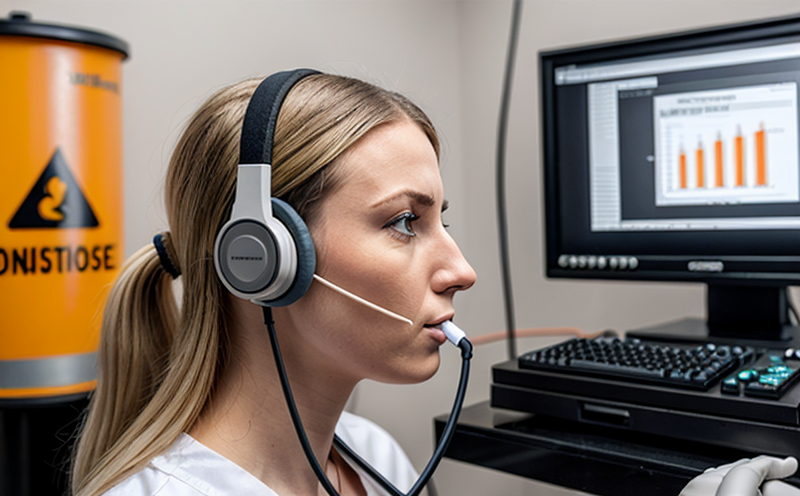ISO 4869-6 Hearing Protector Comfort Assessment Testing
The ISO 4869 series of standards provides a framework for the evaluation and testing of hearing protectors, focusing on their performance in terms of noise reduction, comfort, and fit. Specifically, ISO 4869-6 is dedicated to assessing the comfort level of hearing protectors used in occupational settings.
This standard offers a comprehensive approach to evaluating how hearing protection devices (HPDs) perform under real-world conditions. The testing protocol outlined in ISO 4869-6 ensures that HPDs meet not only noise reduction requirements but also provide an acceptable level of comfort, which is crucial for ensuring compliance with occupational health and safety regulations.
The test procedure described in this standard involves a series of steps designed to simulate the conditions under which workers might typically use hearing protectors. This includes standardized placement methods, consistent testing environments, and the use of specific manikins that mimic human head shapes and sizes. The comfort assessment is based on subjective ratings provided by participants wearing the HPDs during the test.
The methodology for determining comfort levels involves measuring various physiological responses such as skin temperature changes around the ear canal, heart rate variability, and self-reported discomfort scores given by participants. These metrics provide a quantitative measure of how comfortable the hearing protector is perceived to be by its wearer.
Understanding these parameters helps manufacturers design more ergonomic HPDs that not only block out harmful noise but also enhance user satisfaction without compromising on essential functionalities like sound insulation properties. By adhering strictly to ISO 4869-6, laboratories can ensure their testing methods are consistent and reliable across different products and brands.
Compliance with this international standard is particularly important for companies involved in manufacturing or supplying hearing protectors to industries where occupational noise exposure poses significant risks. Adhering to these standards helps maintain high standards of quality control throughout the supply chain, thereby protecting both employees' health and safety while also meeting regulatory requirements.
For organizations looking to validate their HPD offerings against this standard, it is essential they work with accredited laboratories that specialize in acoustics testing. These labs possess the necessary expertise and equipment to conduct rigorous evaluations according to ISO 4869-6 guidelines ensuring accurate results and reliable data reporting.
Why It Matters
The importance of comfort when using hearing protectors cannot be overstated. Comfort directly impacts the willingness of workers to wear their assigned HPDs consistently, which is fundamental in preventing noise-induced hearing loss (NIHL) and other associated health issues.
- Increased Compliance: When employees find it uncomfortable or inconvenient to use provided HPDs, they may remove them during work hours. This non-compliance significantly increases the risk of NIHL.
- Better Fit: Comfortable hearing protectors are more likely to achieve a proper seal around the ear canal, enhancing noise reduction effectiveness.
- Reduced Fatigue: Wearing uncomfortable HPDs can lead to physical discomfort and mental fatigue, reducing overall productivity and job satisfaction.
Incorporating ISO 4869-6 into your quality management system ensures that you are meeting industry best practices for comfort assessment. This standard helps identify potential design flaws early in the development process, leading to better product performance and customer acceptance.
Applied Standards
ISO 4869-6 is one of several standards within the ISO 4869 series that collectively address various aspects of hearing protector evaluation. It aligns closely with other international standards such as ANSI S3.19, which provides additional guidance on noise reduction rating and other performance metrics.
The application of these standards ensures consistency in testing procedures worldwide, facilitating easier trade between countries and reducing barriers to entry for global markets. Compliance with ISO 4869-6 also demonstrates a commitment to international best practices, enhancing your organization's reputation among clients and stakeholders.
Use Cases and Application Examples
| Industry Sector | Occupation Type | HPD Use Case |
|---|---|---|
| Aerospace Manufacturing | Machinists, Assemblers | Evaluating comfort levels of HPDs during extended periods in noisy environments. |
| Construction Industry | Heavy Equipment Operators | Determining the best-fitting and most comfortable HPDs for operators working near jackhammers or other loud machinery. |
| Manufacturing Plants | Assembly Line Workers, Maintenance Technicians | Assessing comfort during long shifts in high-noise areas like stamping presses or conveyor belts. |
- Educational Institutions: Assessing the comfort of HPDs used by students and faculty members during laboratory settings where there is continuous background noise from equipment operation.
- Healthcare Facilities: Ensuring that healthcare workers who spend extended hours in noisy environments, such as emergency departments or intensive care units, are protected both effectively and comfortably.
The data collected through these assessments can inform decisions about which HPDs to supply to specific departments within an organization. It allows companies to tailor their product offerings more closely to the needs of different job roles, improving overall safety and comfort levels across various sectors.





